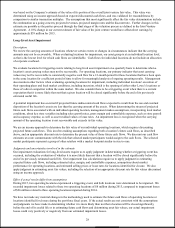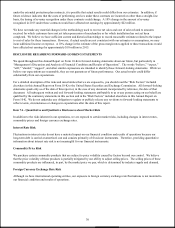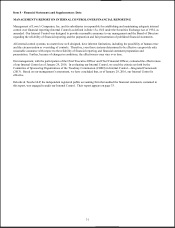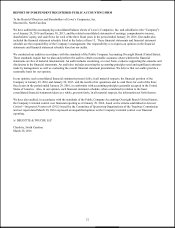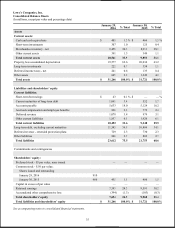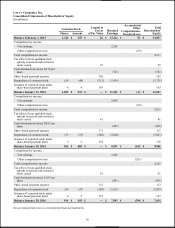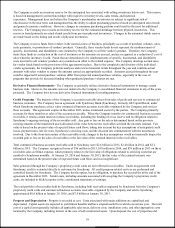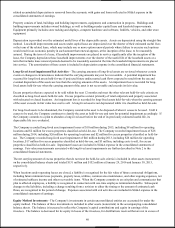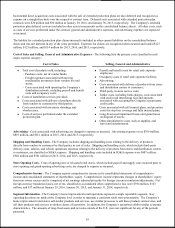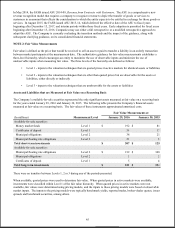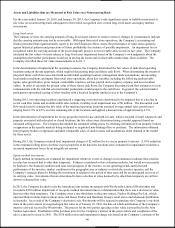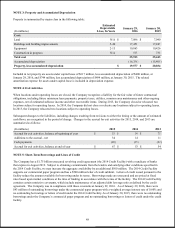Lowe's 2015 Annual Report Download - page 47
Download and view the complete annual report
Please find page 47 of the 2015 Lowe's annual report below. You can navigate through the pages in the report by either clicking on the pages listed below, or by using the keyword search tool below to find specific information within the annual report.
38
NOTES TO CONSOLIDATED FINANCIAL STATEMENTS
YEARS ENDED JANUARY 29, 2016, JANUARY 30, 2015 AND JANUARY 31, 2014
NOTE 1: Summary of Significant Accounting Policies
Lowe’s Companies, Inc. and subsidiaries (the Company) is the world’s second-largest home improvement retailer and operated
1,857 stores in the United States, Canada, and Mexico at January 29, 2016. Below are those accounting policies considered by
the Company to be significant.
Fiscal Year - The Company’s fiscal year ends on the Friday nearest the end of January. Each of the fiscal years presented
contained 52 weeks. All references herein for the years 2015, 2014, and 2013 represent the fiscal years ended January 29,
2016, January 30, 2015, and January 31, 2014, respectively.
Principles of Consolidation - The consolidated financial statements include the accounts of the Company and its wholly-
owned or controlled operating subsidiaries. All intercompany accounts and transactions have been eliminated.
Foreign Currency - The functional currencies of the Company’s international subsidiaries are generally the local currencies of
the countries in which the subsidiaries are located. Foreign currency denominated assets and liabilities are translated into U.S.
dollars using the exchange rates in effect at the consolidated balance sheet date. Results of operations and cash flows are
translated using the average exchange rates throughout the period. The effect of exchange rate fluctuations on translation of
assets and liabilities is included as a component of shareholders’ equity in accumulated other comprehensive loss. Gains and
losses from foreign currency transactions, which are included in selling, general and administrative (SG&A) expense, have not
been significant.
Use of Estimates - The preparation of the Company’s financial statements in accordance with accounting principles generally
accepted in the United States of America requires management to make estimates that affect the reported amounts of assets,
liabilities, sales and expenses, and related disclosures of contingent assets and liabilities. The Company bases these estimates
on historical results and various other assumptions believed to be reasonable, all of which form the basis for making estimates
concerning the carrying values of assets and liabilities that are not readily available from other sources. Actual results may
differ from these estimates.
Cash and Cash Equivalents - Cash and cash equivalents include cash on hand, demand deposits, and short-term investments
with original maturities of three months or less when purchased. Cash and cash equivalents are carried at amortized cost on the
consolidated balance sheets. The majority of payments due from financial institutions for the settlement of credit card and
debit card transactions process within two business days and are, therefore, classified as cash and cash equivalents.
Investments - As of January 29, 2016, investments consisted primarily of money market funds, municipal obligations,
certificates of deposit, and municipal floating rate obligations, all of which are classified as available-for-sale. Available-for-
sale securities are recorded at fair value, and unrealized gains and losses are recorded, net of tax, as a component of
accumulated other comprehensive income. Gross unrealized gains and losses were insignificant at January 29, 2016 and
January 30, 2015.
The proceeds from sales of available-for-sale securities were $394 million, $283 million, and $276 million for 2015, 2014, and
2013, respectively. Gross realized gains and losses on the sale of available-for-sale securities were not significant for any of the
periods presented.
Investments with a stated maturity date of one year or less from the balance sheet date or that are expected to be used in current
operations are classified as short-term investments. All other investments are classified as long-term. Investments classified as
long-term at January 29, 2016, will mature in one to 34 years, based on stated maturity dates.
The Company classifies as investments restricted balances primarily pledged as collateral for the Company’s extended
protection plan program. Restricted balances included in short-term investments were $234 million at January 29, 2016, and
$99 million at January 30, 2015. Restricted balances included in long-term investments were $202 million at January 29, 2016,
and $305 million at January 30, 2015.
Merchandise Inventory - Inventory is stated at the lower of cost or market using the first-in, first-out method of inventory
accounting. The cost of inventory also includes certain costs associated with the preparation of inventory for resale, including
distribution center costs, and is net of vendor funds.


